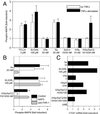Mechanistic coupling of protease signaling and initiation of coagulation by tissue factor
- PMID: 11438726
- PMCID: PMC35412
- DOI: 10.1073/pnas.141126698
Mechanistic coupling of protease signaling and initiation of coagulation by tissue factor
Abstract
The crucial role of cell signaling in hemostasis is clearly established by the action of the downstream coagulation protease thrombin that cleaves platelet-expressed G-protein-coupled protease activated receptors (PARs). Certain PARs are cleaved by the upstream coagulation proteases factor Xa (Xa) and the tissue factor (TF)--factor VIIa (VIIa) complex, but these enzymes are required at high nonphysiological concentrations and show limited recognition specificity for the scissile bond of target PARs. However, defining a physiological mechanism of PAR activation by upstream proteases is highly relevant because of the potent anti-inflammatory in vivo effects of inhibitors of the TF initiation complex. Activation of substrate factor X (X) by the TF--VIIa complex is here shown to produce enhanced cell signaling in comparison to the TF--VIIa complex alone, free Xa, or Xa that is generated in situ by the intrinsic activation complex. Macromolecular assembly of X into a ternary complex of TF--VIIa--X is required for proteolytic conversion to Xa, and product Xa remains transiently associated in a TF--VIIa--Xa complex. By trapping this complex with a unique inhibitor that preserves Xa activity, we directly show that Xa in this ternary complex efficiently activates PAR-1 and -2. These experiments support the concept that proinflammatory upstream coagulation protease signaling is mechanistically coupled and thus an integrated part of the TF--VIIa-initiated coagulation pathway, rather than a late event during excessive activation of coagulation and systemic generation of proteolytic activity.
Figures





References
-
- Coughlin S R. Nature (London) 2000;407:258–264. - PubMed
-
- Camerer E, Rottingen J A, Iversen J G, Prydz H. J Biol Chem. 1996;271:29034–29042. - PubMed
-
- Poulsen L K, Jacobsen N, Sorensen B B, Bergenhem N C, Kelly J D, Foster D C, Thastrup O, Ezban M, Petersen L C. J Biol Chem. 1998;273:6228–6232. - PubMed
-
- Camerer E, Rottingen J A, Gjernes E, Larsen K, Skartlien A H, Iversen J G, Prydz H. J Biol Chem. 1999;274:32225–32233. - PubMed
-
- Pendurthi U R, Allen K E, Ezban M, Rao L V. J Biol Chem. 2000;275:14632–14641. - PubMed
Publication types
MeSH terms
Substances
Grants and funding
LinkOut - more resources
Full Text Sources
Other Literature Sources
Miscellaneous

